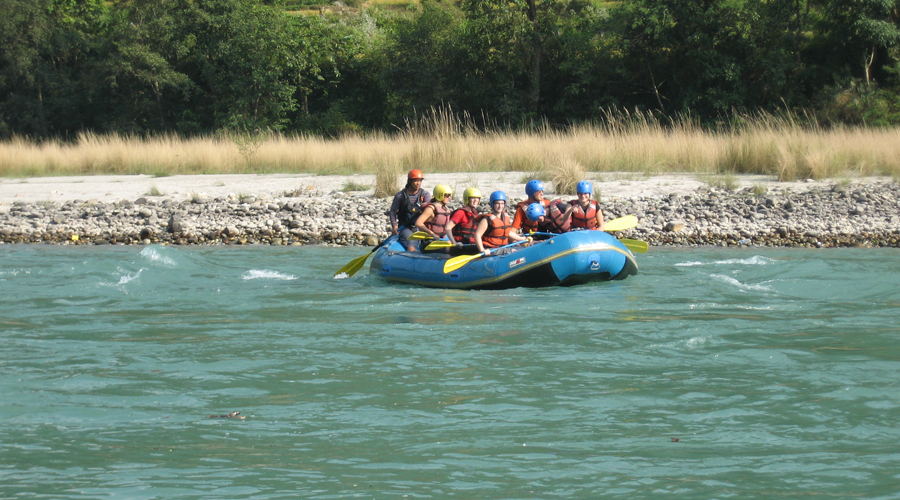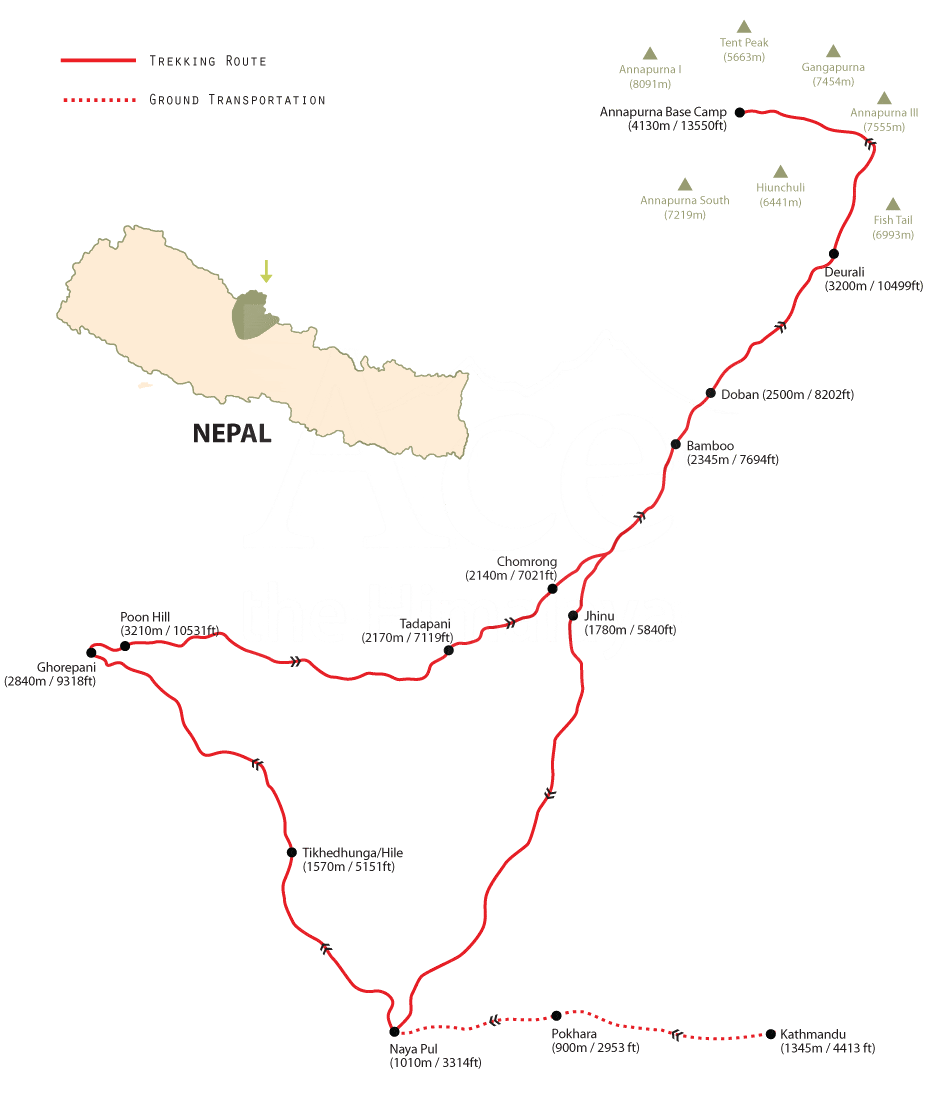Sunkoshi River Rafting

Trip Itinerary
| Day | Highlights | Overnight |
|---|---|---|
| Day 1 | Early morning drive to Balephi (65 Km): Start rafting from Balephi & Raft up to Dolal Ghat.Early in the morning we drive through 65 km route for 3 hours to get to Balephi, our raft put in point. After arriving at Balephi, lunch is served. Prior to rafting all the concerned details are thoroughly briefed out and then equipped with appropriate gear we venture into rafting journey piloted by expert river guide. Paddling along the rhythm of roaring river amid the picturesque landscape, exquisite wilderness and panorama of majestic hills, we head towards Dolal Ghat. On reaching Dolal Ghat, we witness terraced fields and traditional Nepali houses perched on the hillsides and slopes. This glorious adventure concludes for the day with camping at a superb site in Dolal Ghat. |
Balephi |
| Day 2 | Puchar Ghat: We continue rafting against thrashing rapids. By the time this exhilarating river ride meanders against class IV ‘No exit’ and ‘Meatgrinder’ rapids towards Puchar Ghat, it becomes much easier to control the fast-paced whitewater run. Pristine Tamang villages zoom out into picture. Eventually, after hours of succumbing to unparallel rafting challenges we camp at Puchar Ghat. |
Puchar Ghat |
| Day 3 | Dhani Ghat: As the rafting trip advances further, we get more familiarized with the topology of Sun Koshi River. Besides rendezvous with exhilarating scenic rapids, breathtaking scenery and ethno-cultural heritages are the other attractive prospects that make our journey so very enriching, memorable and satisfying. We also enter the confluence of the Likhu Khola. Finally, we camp at Dhani Ghat. |
Dhani Ghat |
| Day 4 | Harkapur: The river trip meets a series of whitewater rapids with various intensities at regular intervals. We encounter amazing boulder-strewn whitewater bonanza! On rafting towards Harkapur, we struggle against class III rapids. The trip gets more challenging and threatening as torrential rapids transforms into V class rapids. Expertise of river guide coupled with extreme precaution and safety measures play key roles at this point. After fun-filled adventurous rafting trip, we camp at Harkapur. |
Harakpur |
| Day 5 | Rai Ghat: Rafting past Harkapur has us encounter with IV class rapids as we enter the confluence of the Dudhkoshi River. Amidst the exotic eco-system and natural vistas, the river widens below the Dudhkoshi and flow through a broad valley after mellowing down. In comparison to Sun Kosi, Dudhkoshi is much colder. After having maneuvered through awesome rapids like Rapid Punch, Juddy, High anxiety, Motorcycle, Harkapur 1, Harkapur 2 and Harkapur 3, we eventually reach Raighat where we set a camp. |
Rai Ghat |
| Day 6 | Rest day: We set aside this day for complete mental and physical rest. After proper rest, we can explore the areas around the campsite. We can even have beauty of nature evidenced in our picturesque snapshots. Viewing the most blissful sight of mesmerizing Mt. Everest is another visual treat sprawled before us. |
Rai Ghat |
| Day 7 | Raswa Ghat: Fighting against rapids like Jaws and Dead Man’s Eddy, we raft past a suspension bridge and a huge eddy. Our heart palpitates with adventure spirit as we paddle ahead for more challenging whitewater rafting. Exotic wilderness and nature remain our witnesses all through this thrilling river trip. Our river guide provides us informative tidbits from time and again. We conclude the trip of the day by lastly camping at Raswa Ghat. |
Raswa Ghat |
| Day 8 | River Ghat: Making our way through wild verdant vegetation, rock-strewn cliff and house-sized boulders, we bounce and splash against the untamed river. Further ahead, we encounter continuous white water with rapids like Rhino Rocks and Jungle Corridor. We will be treated with awesome view of exotic wilderness, pristine hamlets and picturesque landscape. As we near River Ghat, we look out for a suitable campsite. |
River Ghat |
| Day 9 | Ranitar: As the untamed river cuts against the rocky banks, crash into rocks and crevices breaking into foaming white water rapids, we position the raft securely abiding the instructions of our river guide. Enjoying the stunning scenery, we white water raft through narrow canyons and furious rapids like Chamere Ghat and Darsandhun Ghat. After arriving at Ranitar, we put a halt to the trip for the day and camp at a fantastic location. |
Ranitar |
| Day 10 | Chatara, Pick up and Drive to Biratnagar: Departing from Ranitar, we paddle along imperial rapid, Big dipper. Soon after discovering enchanting waterfalls and paradisiacal side canyons, we enter Tribeni Ghat, the confluence of river Arun, Tamur and beginning of the Sapta Koshi River. Holding onto the cherishing memories of the trip, we bid farewell to our rafting journey after arriving at Chatara. There is a Barahkshetra temple lying in the vicinity of Chatara. We can visit this temple to pay our homage to lord Vishnu. Thereafter, we drive to Biratnagar. |
Biratnagar |
| Day 11 | Biratnagar – Kathmandu by flight then transfer to Hotel. | Kathmandu |
Note: If above itinerary couldn't meet your needs, we can design a tailor-made itinerary to suit your needs. It is also possible to combine with some other activities such as Tibet tours, Bhutan tours, and Jungle safari in Nepal.
Trip Date & Cost
Cost Includes
- Transportation to & from Kathmandu by Van, Hiace, Mini Bus or Tourist Bus as per itinerary.
- All International standard rafting equipment as necessary (Such as self bailing rafts, helmets, life jackets, kayaks, plastic paddles and spray jackets etc.)
- Well-trained and highly experienced English speaking rafting guides, cooks, and other helper staff.
- 3 times’ a day continental & Nepalese meals during the rafting period (breakfast, lunch & dinner)
- Camping & Cooking equipment (tents, mattress & kitchen utensil).
- Accommodation at twin sharing tent during the rafting en-route.
- All staffs daily wages, insurance and meals etc.
- All necessary fees for rafting permit, Government local taxes, all national park and conservation area fees.
Cost Excludes
- Land transportation Airport/Hotel/Airport pick up & drop.
- Hotel Accommodation in Kathmandu with all 3 meals.
- Drinks except tea & Coffee: Any type of personal expenditure such Alcoholic beverages and drinks, phone, and laundry.
- Cost for incase of any natural accident caused by weather.
- Rescue & insurance such as travel, cancellation, accident, health, emergency evacuation & loss, theft of or damage to baggage & personal effects.
- Tips, Gratuities and expenditure.
Equipment for this trip.
The following gives you a general idea of the trekking equipment and clothing needed for this trek.
This is a porter-supported trek. Two clients share one porter. We will supply you a trek duffel bag where you keep your heavy items and this bag is carried by the porter. You will need to bring your own daypack to be carried by you. In the daypack, you can put money, important documents, water bottle/bladder, camera, toiletries, sunscreen, notebook, etc.
The weight limit for the porter is 30 kg or 66 pounds. 15 kg or 33 pounds for each client. So, we recommend you to pack as carefully as you can and not exceed the weight limit. You can leave your non-trekking stuff at the locker facility in the Kathmandu hotel.
General
- 4-season sleeping bag (We can provide one if you need it but has to be returned after the trek.)
- Duffel bag (We will provide one complimentary Ace the Himalaya duffel bag which is yours to keep.)
- Daypack
- Down jacket (Must have for mornings, nights and evenings, and for altitudes above 4,000 m; We can provide it if you need one but has to be returned after the trek.)
Upper Body - Head / Ears / Eyes
- Sun hat (We will provide you a complimentary Ace the Himalaya hat.)
- Wool or synthetic hat that cover the ears
- Sunglasses with UV protection
- Headlamp
- Neck warmer
Hand
- Liner gloves
- Heavier shell gloves
Core Body
- T-shirts
- Lightweight expedition thermal tops
- Fleece jacket or pullover
- Water/windproof shell jacket (Preferably breathable fabric)
- Synthetic sports bras (For women)
Lower Body – Legs
- Lightweight expedition thermal bottoms
- Nylon hiking shorts
- Soft shell and hard shell trekking pants
- Water/windproof trousers
- Casual pants
Feet
- Liner socks
- Heavyweight socks
- Waterproof hiking/trekking boots
- Light shoes/sneakers/sandals
- Gaiters (For monsoon and winter)
Medicines and First Aid Kits
(Please note our guide will carry the first-aid kit bag during the trek. However we still recommend you to bring your personalized first-aid kit as well.)
- Extra Strength Excedrin for altitude related headaches
- Ibuprofen for general aches and pains
- Immodium or Pepto Bismol capsules for upset stomach or diarrhea
- Diamox (commonly prescribed as Acetazolamide) 125 or 250mg tablets for altitude sickness
- Anti-infection ointments
- Band-aids
- Lip balm (At least SPF 20)
- Sunscreen (SPF 40)
Miscellaneous, but Important!
- Passport and extra passport photos (3 copies)
- Airline ticket (Please make a copy and leave one at our office in Kathmandu just in case if you need to change the date of your flight.)
- Durable wallet/pouch for travel documents, money & passport
- Water bottle/bladder
- Water purification Iodine tablets
- Toiletry kit (Be sure to include toilet paper stored in a plastic bag, hand wipes, and liquid hand sanitizer, towel, soap, etc.)
Optional
- Adjustable trekking poles
- Favorite snack foods (No more than 2 pounds)
- Paperback books, cards, mp3 player
- Binoculars
- Cameras (Memory cards, chargers and also batteries)
- Pee bottle for men and pee funnel for woman
This list is only a guide. While you are required to bring everything on this list, there are numerous options, brands, and versions of each piece of equipment. Use your experience and the listed features to find the best gear for you. Some of the above equipment can be easily found in stores in Kathmandu for cheaper prices.
Note: Tight fitting, figure-hugging clothing such as those made with Lycra can often be offensive to locals, especially to women. If you find these items comfortable as a base layer, please pack something to wear on top of them.
